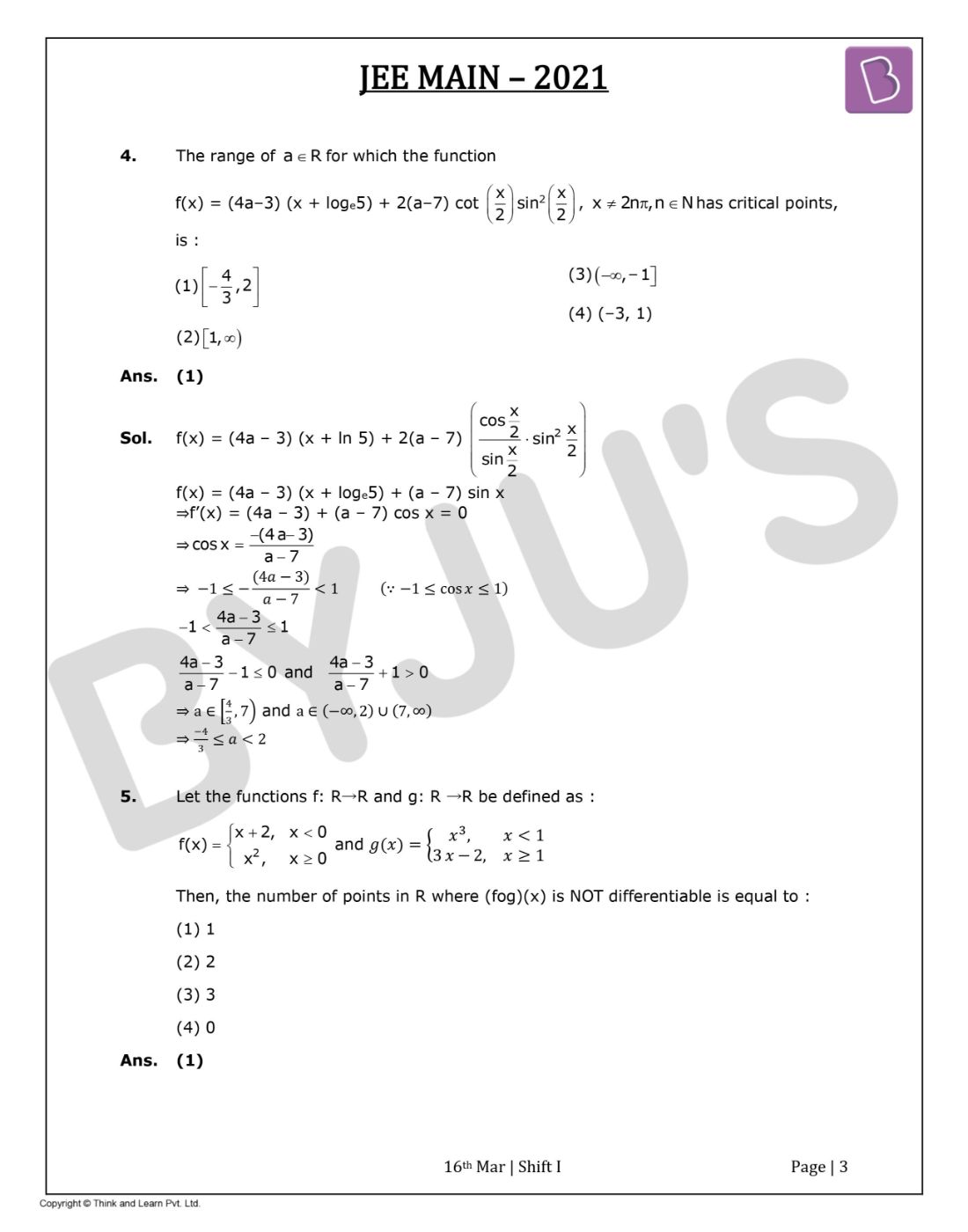JEE Main 2021 question paper for Maths (March 16 – Shift 1) is provided here along with solutions that have been exclusively created by our subject experts. Candidates will find the Maths solved questions and these will help them to check the correct answers as well as analyze their performance. Students can download the JEE Main 2021 March 16th Shift 1 Maths Question Paper in a PDF format for studying and practicing offline to improve their speed and accuracy.
Section A
Question 1: Consider three observations a, b and c such that b = a+c. If the standard deviation of a+2, b+2, c+2 is d, then which of the following is true?
a. b2 = a2 + c2 + 3d2
b. b2 = 3 (a2 + c2) – 9d2
c. b2 = 3 (a2 + c2) + 9d2
d. b2 = 3 (a2 + c2 + d2)
Answer: (b)
For a, b, c mean =
S.D. of a, b, c = d 
d2 = [a2 + b2 + c2] / 3 – (4b2 / 9)

b2 = 3a2 + 3c2 – 9d2
Question 2: Let a vector
a. 1
b. 1 / 2
c. 1 / √2
d. 2 √2
Answer: (b)

(ɑ, β) = (2 cos 75o, 2 sin 75o)
Area = (1 / 2) (2 cos 75°)(2 sin 75°)
= sin (150°)
= 1 / 2 square unit
Question 3: If for a>0, the feet of perpendiculars from the points A (a, –2a, 3) and B (0, 4, 5) on the plane lx + my + nz = 0 are points C (0, –a, –1) and D respectively, then the length of line segment CD is equal to :
a. √41
b. √55
c. √31
d. √66
Answer: (d)

Direction cosines of plane = λ (direction cosines of line AC)
Direction cosines of plane = λa, – λa, 4λ
Hence equation plane is: ax – ay + 4z = 0
The point C lies on the plane
a (0) − a (− a)+ 4 (−1) = 0 ⇒ a = 2 (∵ a > 0)
So plane is 2x − 2y + 4z = 0, C ≡ (0,−2,−1)
So for coordinates of D,
[x – 0] / 2 = [y – 4] / – 2 = [z – 5] / 4 = – {[2 (0) – 2 (4) + 4 (5)] / [22 + 22 + 42]}D ≡ (- 1, 5, 3)
CD = √66 units
Question 4: The range of a ∈ R for which the function f (x) = (4a – 3) (x + loge 5) + 2 (a – 7) cot (x / 2) sin2 (x / 2), x ≠ 2nπ, n ∈ N has critical points, is
a. [- 4 / 3, 2]
b. [1, ∞)
c. (- ∞, – 1]
d. (– 3, 1)
Answer: (a)
f (x) = (4a – 3) (x + ln 5) + 2(a – 7) [(cos (x / 2) / sin (x / 2)) * sin2 (x / 2)]
f (x) = (4a – 3) (x + loge5) + (a – 7) sin x
f’ (x) = (4a – 3) + (a – 7) cos x = 0
cos x = – (4a – 3) / (a – 7)
– 1 ≤ – (4a – 3) / (a – 7) ≤ 1 (because – 1 ≤ cos x ≤ 1)
– 1 < [4a – 3] / [a – 7] ≤ 1
{[4a – 3] / [a – 7]} – 1 ≤ 0 and {[4a – 3] / [a – 7]} + 1 > 0
a.∈ [4 / 3, 7) and a ∈ (- ∞, 2) ⋃ (7, ∞)
(- 4 / 3) ≤ a < 2
Question 5: Let the functions f: R→R and g: R →R be defined as:
a. 1
b. 2
c. 3
d. 0
Answer: (a)
Clearly fog(x) is discontinuous at x = 0 then non-differentiable at x = 0
Now,
at x = 1
RHD = limh→0+ [f (1 + h) – f (1) ] / [h] = limh→0+ {[3 (1 + h) – 2]2 – 1} / h = 6
LHD = limh→0- [f (1 – h) – f (1) ] / [- h] = limh→0- [(1 – h)6 – 1] / – h = 6
Number of points of non-differentiability = 1
Question 6:Let a complex number z, |z| ≠ 1, satisfy log1/√2 [(|z| + 11) / (|z| – 1)2] ≤ 2. Then, the largest value of |z| is equal to ____
a. 5
b. 8
c. 6
d. 7
Answer: (d)
[(|z| + 11) / (|z| – 1)2] ≥ 1 / 22|z| + 22 ≥ (|z| – 1)2
2|z| + 22 ≥ |z|2 – 2|z| + 1
|z|2 – 4|z| – 21 ≤ 0
(|z| – 7) (|z| + 3) ≤ 0
|z| ≤ 7
|z|max = 7
Question 7: A pack of cards has one card missing. Two cards are drawn randomly and are found to be spades. The probability that the missing card is not a spade is:
a. 3 / 4
b. 52 / 867
c. 39 / 50
d. 22 / 425
Answer: (c)
= [1 – (13 / 52) * (13 / 51) (12 / 50)] / [(1 – (13 / 52) * {(13 / 51) (12 / 50) + (13 / 52) (12 / 51) * (11 / 50)}]
= 39 / 50
Question 8: If n is the number of irrational terms in the expansion of [31/4 + 51/8]60, then (n – 1) is divisible by
a. 8
b. 26
c. 7
d. 30
Answer: (b)
Tr+1 = 60Cr (31/4)60-r (51/8)r
It is rational if [60 – r] / 4, (r / 8), both are whole numbers, r ∈ {0,1,2,….60}
[60 – r] / 4 ∈ W ⇒ r ∈ {0, 4, 8, ……..60} and (r / 8) ∈ W ⇒ r ∈ {0,8,16,…56}Common terms r ∈ {0,8,16,….56}
So 8 terms are rational
Then irrational terms = 61 – 8 = 53 = n
∴n – 1 = 52 = 13 × 22
The factors are 1,2,4,13,26,52.
Question 9: Let the position vectors of two points P and Q be 3i – j + 2k and i + 2j – 4k, respectively. Let R and S be two points such that the direction ratios of lines PR and QS are (4, –1, 2) and (–2,1,–2) respectively. Let lines PR and QS intersect at T. If the vector TA is perpendicular to both PR and QS and the length of vector TA is √5 units, then the modulus of a position vector of A is:
a. √5
b. √171
c. √227
d. √482
Answer: (b)
P = 3i – j + 2k and Q = i + 2j – 4k
vPR = (4, – 1, 2) and vQS = (- 2 , 1, – 2)

LPR = (3i – j + 2k) + λ (4i – 1j + 2k)
LQS : r = (i + 2j – 4k) + 𝝁 (- 2i + 1j – 2k)
Now T on PR = (3 + 4λ, – 1 – λ, 2 + 2λ)
Similarly T on QS = (1 − 2𝝁, 2 + 𝝁,−4 − 2𝝁)
For λ and 𝝁:
3 + 4λ = 1 – 2𝝁 ⇒ 𝝁 + 2λ = – 1 ⇒ λ = 2
– 1 – λ = 2 + 𝝁 ⇒ 𝝁 + λ = – 3 ⇒ 𝝁 = – 5
And 2 + 2λ = – 4𝝁
T : (11, – 3, 6)
D.R. of TA = vQS x vPR
LTA : r = (11i – 3j + 6k) + λ (- 4j – 2k)
Now A = (11,− 3 − 4λ, 6 − 2λ)
TA = √5
(4λ)2 + (2λ)2 = 5
16λ2 + 4λ2 = 5
λ = ± 1 / 2
A: (11, –5, 5) or A: (11, –1, 7)
|A| = √(121 + 25 + 25) or |A| = √(121 + 1 + 49)
= √171 or √171
Question 10: If the three normals drawn to the parabola, y2 = 2x pass through the point (a, 0) a ≠ 0, then ‘a’ must be greater than
a. 1
b.1 / 2
c. – 1 / 2
d. –1
Answer: (1)
Let the equation of the normal be y = mx – 2am – am3.
Here 4a = 2
a = 1 / 2
y = mx – m – (1 / 2) m3
It passes through A (a, 0) then
0 = am – m – (1 / 2) m3
m = 0, m2 – 2 (a – 1) = 0
For real values of m
2 (a – 1) > 0
a > 1
Question 11: Let Sk = ∑r=1k tan-1[(6r) / (2r+1 + 32r+1)]. Then limk→∞ Sk =
a. tan-1 (3 / 2)
b. cot-1 (3 / 2)
c. π / 2
d. tan–1(3)
Answer: (2)

Question 12: The number of roots of the equation, (81)sin2x + (81)cos2x = 30 in the interval [0, π] is equal to :
a. 3
b. 2
c. 4
d. 8
Answer: (3)
(81)sin2x + (81)cos2x = 30
(81)sin2x + [81 / (81)sin2x] = 30
Let (81)sin2x = t
t + (81 / t) = 30 ⇒ t2 + 81 = 30t
t2 – 30t + 81 = 0
t2 – 27t – 3t + 81 = 0
(t – 3) (t – 27) = 0
t = 3, 27
(81)sin2x = 3, 33
34sin2x = 31, 33
4 sin2 x = 1, 3
sin2 x = (1 / 4), (3 / 4) in [0, π] sin x ≥ 0
sin x = 1 / 2, √3 / 2
x = π / 6, 5π / 6, π / 3, 2π / 3
Number of solutions = 4
Question 13: If y = y(x) is the solution of the differential equation, dy / dx + 2y tanx = sinx, y (π / 3) = 0, then the maximum value of the function y(x) over R is equal to :
a. 8
b. 1 / 2
c. – 15 / 4
d. 1 / 8
Answer: 4
dy / dx + 2y tanx = sinx
IF = eln (sec2x) = sec2 x
y sec2x = ∫tanx secx dx = secx + c
Now, x = π / 3, y = 0, c = – 2
y = cosx – 2cos2 x
y = – 2 [cos2 x – (1 / 2) cosx] = – 2 [(cosx – (1 / 4))2 – (1 / 16)]
y = (1 / 8) – 2 [cosx – (1 / 4)]2
ymax = 1 / 8
Question 14: Which of the following Boolean expression is a tautology?
a. (p ∧ q) ∧ (p → q)
b. (p ∧ q) ∨ (p ∨ q)
c. (p ∧ q) ∨ (p → q)
d. (p ∧ q) → (p → q)
Answer: (4)
|
p |
q |
p ∧ q |
p ∨ q |
p → q |
(p ∧ q) → (p → q) |
|
T |
T |
T |
T |
T |
T |
|
F |
T |
F |
T |
T |
T |
|
T |
F |
F |
T |
F |
T |
|
F |
F |
F |
F |
T |
T |
Question 15: Let
a. No solution
b. Exactly two solutions
c. A unique solution
d. Infinitely many solutions
Answer: (1)

Question 16: If for x ∈ (0, π / 2), log10sin x + log10cos x = –1 and log10(sin x+cos x) = 1 / 2 (log10 n – 1), n>0, then the value of n is equal to:
a. 16
b. 20
c. 12
d. 9
Answer: (3)
log10sin x + log10cos x = –1
sinx * cosx = 1 / 10 — (1)
log10 (sinx + cosx) = (1 / 2) (log10 n – 1)
(sinx + cosx) = (n / 10)½
sin2 x + cos2 x + 2 sinx cosx = n / 10 (squaring)
1 + 2 (1 / 10) = n / 10 [using equation (1)]
n / 10 = 12 / 10
n = 12
Question 17: The locus of the midpoints of the chord of the circle, x2 + y2 = 25 which is tangent to the hyperbola, x2 / 9 – y2 / 16 = 1 is :
a. (x2 + y2)2 – 16x2 + 9y2 = 0
b. (x2 + y2)2 – 9x2 + 144y2 = 0
c. (x2 + y2)2 – 9x2 – 16y2 = 0
d. (x2 + y2)2 – 9x2 + 16y2 = 0
Answer: (4)
The tangent of hyperbola y = mx ± √(9m2 – 16) …(i) which is a chord of circle with mid-point (h, k).
So, the equation of chord T = S1
hx + ky = h2 + k2
y = – (hx / k) + (h2 + k2) / k —- (ii)
By (i) and (ii)
m = – h / k and √9m2 – 16 = [h2 + k2] / k
9 (h2 / k2) – 16 = (h2 + k2)2 / k2
The locus 9x2 – 16y2 = (x2 + y2)2.
Question 18: Let [x] denote the greatest integer less than or equal to x. If for n ∈ N, (1 – x + x3)n = ∑j=03n ajxj, then ∑j=03n/2 a2j + 4 ∑j=0(3n-1)/2 a2j+1 =
a. 1
b. n
c. 2n–1
d. 2
Answer: (1)
(1 – x + x3)n = ∑j=03n ajxj
(1–x + x3)n = a0 + a1x + a2x2 + ….. + a3n x3n
Put x = 1
1 = a0 + a1 + a2 + a3 + a4 + …… +a3n …(1)
Put x = –1
1 = a0 – a1 + a2 – a3 + a4 …… (–1)3na3n …(2)
Add (1) + (2)
a0 + a2 + a4 + a6 + …….. = 1
Sub (1) – (2)
⇒ a1 + a3 + a5 + a7 + …….. = 0
Now ∑j=03n/2 a2j + 4 ∑j=0(3n-1)/2 a2j+1 =
= (a0 + a2 + a4 + …..) + 4(a1 + a3+ ….)
= 1 + 4 × 0
= 1
Question 19: Let P be a plane lx + my + nz = 0 containing the line, [1 – x] / 1 = [y + 4] / 2 = [z + 2] / 3. If plane P divides the line segment AB joining points A (–3, –6, 1) and B (2, 4, –3) in ratio k : 1 then the value of k is equal to :
a. 1.5
b. 2
c. 4
d. 3
Answer: (2)

Line lies on plane
– l + 2m + 3n = 0 …(1)
Point on line (1,– 4, – 2) lies on plane
l – 4m – 2n = 0 …(2)
From (1) & (2)
–2m + n = 0
2m = n
l = 3n + 2m
l = 4n
l : m : n :: 4n : (n / 2) : n
l : m : n :: 8n : (n) : 2n
l : m : n :: 8 : 1 : 2
Now equation of plane is 8x + y + 2z = 0
R divide AB is ratio k : 1
R : [(- 3 + 2k) / (k + 1), (- 6 + 4k) / (k + 1), (1 – 3k) / (k + 1)] lies on the plane
8 [(- 3 + 2k) / (k + 1) + (- 6 + 4k) / (k + 1) + 2 (1 – 3k) / (k + 1)] = 0
–24 + 16 k – 6+ 4k + 2 – 6k = 0
–28 + 14k = 0
k = 2
Question 20: The number of elements in the set x ∈ R : (|x| – 3) |x + 4| = 6) =
a. 2
b. 1
c. 3
d. 4
Answer: (1)
Case – 1: x ≤ – 4
(–x – 3)(–x – 4) = 6
(x + 3) (x + 4) = 6
x2 + 7x + 6 = 0
x = –1 or – 6
But x ≤ – 4
x = – 6
Case – 2: x ∈ (– 4, 0)
(–x – 3)(x + 4) = 6
–x2 – 7x – 12 – 6 = 0
x2 + 7x + 18 = 0
D < 0 No solution
Case – 3: x ≥ 0
(x – 3)(x + 4) = 6
x2 + x – 12 – 6 = 0
x2 + x – 18 = 0
x = (- 1 ± √73) / 2
Only x = (√73 – 1) / 2
Hence, 2 elements only
Section – B
Question 21: Let f: (0, 2) → R be defined as f (x) = log2 [1 + tan (πx / 4)]. Then, limn→∞ (2 / n) [f (1 / n) + f (2 / n) ……. f (1)] is equal to ______
Answer: (1)

Question 22: The total number of 3 × 3 matrices A having entries from the set {0, 1, 2, 3} such that the sum of all the diagonal entries of AAT is 9, is equal to ____
Answer: (766)
Tr (AAT) = x2 + y2 + z2 + a2 + b2 + c2 + d2 + e2 + f2 = 9
all→1 =1
one 3, rest = 0 (9! / 8!) = 9
two 2 , one 1 & rest 0 (9!) / (2! 6!) = 63 × 4 = 252
one 2 , five 1, rest 0 (9!) / (5! 3!) = 63 × 8 = 504
Total = 766
Question 23: Let f:R→R be a continuous function such that f (x) + f (x + 1) = 2, for all x ∈ R. If I1 = ∫08 f (x) dx and I2 = ∫-13 f (x) dx, then the value of I1 + 2I2 is equal to ____
Answer: (16)
f (x) + f (x + 1) = 2 …..(i)
x→(x + 1)
f(x + 1) + f(x + 2) = 2 …..(ii)
By (i) & (ii)
f(x) – f(x + 2) = 0
f(x + 2) = f(x)
f(x) is periodic with T = 2
I1 = ∫02*4 f (x) dx = 4 ∫02 f (x) dx
I2 = ∫-13 f (x) dx = ∫04 f (x + 1) dx = ∫04 [2 – f (x)] dx
I2 = 8 – 2 ∫02 f (x) dx
I1 + 2I2 = 16
Question 24: Consider an arithmetic series and a geometric series having four initial terms from the set {11, 8, 21, 16, 26, 32, 4}. If the last terms of these series are the maximum possible four-digit numbers, then the number of common terms in these two series is equal to ____
Answer: (3)
By observation
A.P : 11, 16, 21, 26 …….
G.P : 4, 8, 16, 32 …….
So common terms are 16, 256, 4096.
Question 25: If the normal to the curve y (x) = ∫0x (2t2 – 15t + 10) dt at a point (a, b) is parallel to the line x + 3y = – 5, a>1, then the value of |a + 6b| is equal to ____
Answer: (406)
y’ (x) = (2x2 – 15x + 10)
At point (a, b) normal is
3 = (2a2 – 15a + 10)
2a2 – 15a + 7 = 0
2a2 – 14a – a + 7 = 0
2a (a – 7) – 1 (a – 7) = 0
a = 1 / 2 or 7,
Given a > 1, a = 7
Also P lies on curve,
b = ∫0a (2t2 – 15t + 10) dt
b = ∫07 (2t2 – 15t + 10) dt
6b = – 413
|a + 6b| = 406
Question 26: If limx→0 [aex – b cosx + ce-x] / [x sinx] = 2, then a + b + c is equal to ______
Answer: (4)

a – b + c = 0 & a – c = 0 & (a / 2) + (b / 2) + (c / 2) = 2
a + b + c = 4
Question 27: Let ABCD be a square of the side of unit length. Let a circle C1 centred at A with a unit radius is drawn. Another circle C2 which touches C1 and the lines AD and AB is tangent to it, is also drawn. Let a tangent line from point C to the circle C2 meet the side AB at E. If the length of EB is ɑ + √3β, where ɑ, β are integers, then ɑ + β is equal to ___
Answer: (1)

(i) √2r + r = 1
r = 1 / (√2 + 1)
r = √2 – 1
(ii) CC2 = 2√2 – 2 = 2 (√2 – 1)
From △CC2N = sin ɸ = (√2 – 1) / [2 (√2 – 1)]
ɸ = 30o
(iii) In △ACE are sine law
AE / sin ɸ = AC / sin 105o
AE = (1 / 2) * (√2 / (√3 + 1)) * 2√2
AE = 2 / (√3 + 1) = √3 – 1
EB = 1 – (√3 – 1)
ɑ = 2, β = – 1
ɑ + β = 1
Question 28: Let z and w be two complex numbers such that
Answer: (4)
Let z = x + iy
|z + i| = |z–3i|
y = 1
Now w = x2 + y2 – 2x – 2iy + 2
w = x2 + 1 – 2x –2i + 2
Re(w) = x2 – 2x + 3
Re(w) = (x–1)2 + 2
Re(w)min at x = 1
z = 1 + i
Now w = 1 + 1 –2 – 2i + 2
w = 2(1–i) = 2√2 ei(-π/4)
wn = 2√2 ei(-π/4)
If wn is real, n = 4
Question 29: Let
Answer: (36)
|P-1AP – I|2
= |(P-1AP – I) (P-1AP – I)|
= |P-1APP-1 AP – 2P-1AP + I|
= |P-1A2P – 2P-1AP + P-1IP|
= |P-1(A2 – 2A + I) P|
= |P-1(A – I)2 P|
= |P-1| |A – I|2 |P|
= |A – I|2
=
= (1 (𝛚 (𝛚 + 1) + 𝛚) – 7𝛚 + 𝛚2 . 𝛚)2
= (𝛚2 + 2𝛚 – 7𝛚 + 1)2
= (𝛚2 – 5𝛚 + 1)2
= (- 6𝛚)2
= 36𝛚2 ⇒ ɑ = 36
Question 30: Let the curve y=y(x) be the solution of the differential equation, dy / dx = 2 (x + 1). If the numerical value of area bounded by the curve y = y(x) and the x-axis is 4√8 / 3, then the value of y(1) is equal to ___
Answer: (2)
y = x2 + 2x + c

Area of rectangle ABCD = |(c – 1)√(1 – c)|
Area of parabola and x-axis = 2 (2 / 3 [(1 – c)3/2]) = 4√8 / 3
1 – c = 2
c = –1
Equation of f (x) = x2 + 2x – 1
f (1) = 1 + 2 – 1 = 2































Comments